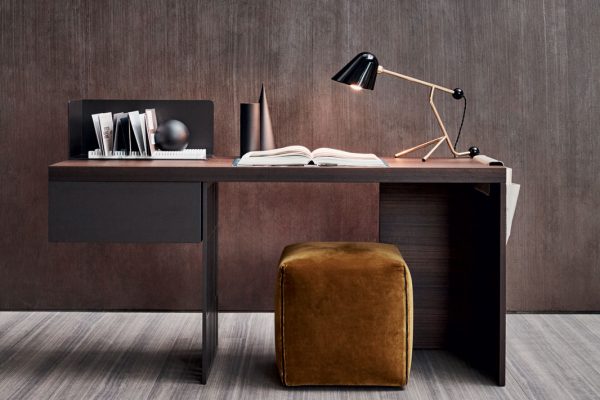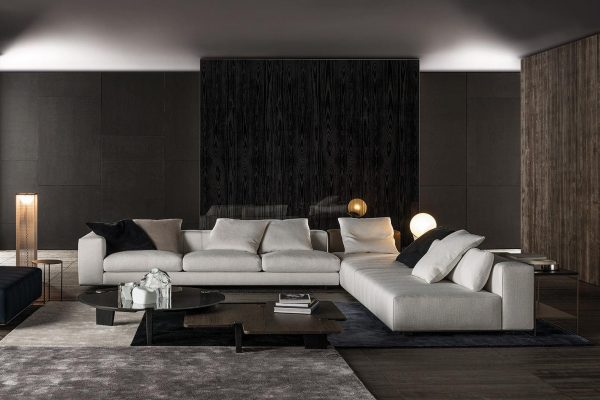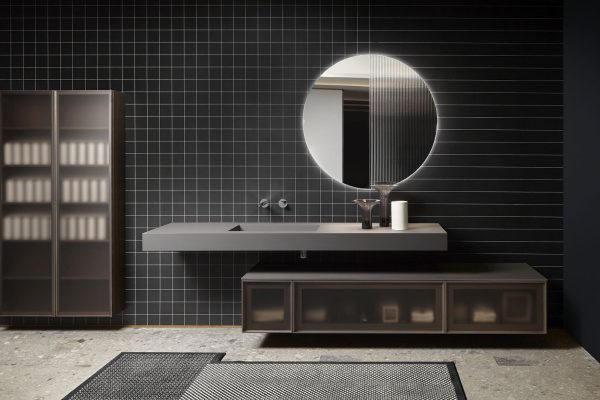Porro, the excellence of made in Italy at the service of high-end design
Refinement of lines, refinement of finishes and technical quality of details. These are just some of the characteristics of Porro, a company founded in 1925 in Brianza, Italy, the traditional cradle of quality furniture production, which today has become an international symbol of a quality made in Italy that combines technology, tradition and variety of solutions. It was in Montesolaro di Carimate that brothers Giulio and Stefano Porro opened their workshop in 1925, aimed at producing stylish furniture for the newly formed Milanese middle class.
The transition to the second Porro generation, with cousins Carlo, Arturo and Silvio, marked the turn to the modern in the 1950s, thanks in part to the long and fruitful collaboration witharchitect Giulio Moscatelli, who in 1955 designed the new workshop near the family home. The company has been linked since its origins to some of the most important names in Italian design, such as Bruno Munari, who was commissioned in 1966 to design the company’s trademark. From the mid-1980s with the entry of the third generation, cousins Lorenzo, Fabio, Giovanni and Danilo Porro, into the company, design took a leading role: at this time the collaboration with Piero Lissoni, art director since 1989, began, who signed over the years some of the company’s icons that perfectly reflect the brand’s formal cleanliness.
Participation in the Cologne Furniture Fair, collaboration with German designers Werner Aisslinger and Wolfgang Tolk, and entry into the German market were the first steps in a process of internationalization that was consolidated in the 1990s, with the creation of a worldwide network of agents, and participation in exhibitions on 5 continents. Subsequent openness to outside designers, including Christophe Pillet, Jean Marie Massaud, le Front, Alessandro Mendini, Soda Designers, GamFratesi, has further enriched the Porro catalog: a choral offering where one can read several hands, different sensibilities but consistent in image and able to satisfy the most demanding tastes together.
The culture of furniture as a family heritage, together with the diktats that guide production, namely formal cleanliness, geometricity of forms and functionality, are the atouts that have enabled Porro to tiptoe its way into a wide space on the international market, without betraying its origins. The company has also been able over the years to reinterpret important traditions such as carving, curved wood, marquetry and the juxtaposition of wood strips in a modern, abstract vision, resulting in quality designs. Their products are immediately recognizable by an identifiable essential language that favors simplification of signs, geometries, and shapes, without losing sight of even in the most complex production processes simplicity.
Byron, the bed designed by Lissoni in which soft lines and geometries meet
Sophisticated, rigorous but also romantic is Porro’s Byron bed, which bears the unmistakable touch of Piero Lissoni. This is a textile model with an intimate and compact shape, which consists of 3 ingredients: the high, upholstered bed frame slightly raised from the floor, the soft headboard cushions, and the screen at the bottom that seems to embrace the space and protect rest.
Soft lines and rounded edges characterize the textile part of the bed while the screen shows a rigorous geometry. The latter is precisely Byron’s sophisticated detail: a solid black-stained ash frame encloses a straw weave, available in a variety of graphic patterns and colors, or wood panels in a black-stained ash finish.
Inlay, refined container between carvings and modern forms
With Inlay, a series of home storage units designed by Front, Porro recaptures the refined inlay work of tradition and makes it a thoroughly contemporary motif. Sharp-edged squares, rectangles and trapezoids decorate the surfaces: minutely juxtaposed, they form an intricate geometric pattern, a pattern where alternating 4 different natural shades of oak create three-dimensional effects and generate virtual volumes.
The sideboard has a distinctive opening with asymmetrical cut and internally is equipped with simple shelves and dividers. The dresser has 2 drawers each with 2 internal trays and single front. Inlay’s handles are solid oak: the interiors of the sideboard and dresser are natural oak.
Load-it, the multitasking library designed by Wolfgang Tolk
Versatile and textural, with a modern and minimalist flavor, Load-it is a multitasking bookcase that can be declined into different functions of daily use. It consists of slender L shelves made in wax-finished high-strength steel finishes, painted white or in the special textural finishes of burnished brass, porphyry gray or antique red.
The product is completed with wall panels available in a variety of sizes, customizable to size, and in many finish variations: starting with matte and glossy lacquer, through woods from the Porro Collection, mirror, wax-finished steel, burnished brass, porphyry gray, and antique red textural finishes, all the way to fabric, which is present with a sample selection or the option of using a customer fabric, and natural and black-dyed cannetè.
Bookmarks, also made of sheet steel in the same finishes as the shelf, complete the product. The uniqueness of this library also lies in its ability to mix with the Modern system to further expand its composite and usage variants.
Romby by GamFratesi, geometric allure and vintage-inspired design
They have an abstract appeal, the Romby chairs made for Porro by GamFratesi.
Perfect in a dining room or work environment, these are cocoon armchairs with impeccable proportions and workmanship that welcome the body, leaving it free to move, enveloping it with a feeling of great lightness. They consist of two structural elements in dimensional and material balance.
A truncated cone base of solid ash wood, natural sandblasted or stained black, connects to a soft and compact upholstered swivel seat. The swivel one is composed of 12 solid-wood planks jointed and later turned and brushed through expert cabinet-making until a perfect truncated cone is obtained on which the natural grain of the solid wood stands out. The upholstered seat is the result of a foamed mold and a tight, perfectly finished upholstery that creates a soft, enveloping shell.
Materic, Piero Lissoni’s sculptural table with refined materials
The Materic table, designed by Piero Lissoni, is a sculptural object that contrasts the absolute simplicity of form with the refinement of materials and workmanship.
It consists of a circular, tapered top resting on a truncated cone base and is available in 2 variants: marble top with wooden base, or wooden top with metal base. The marble top is available in 7 variations ranging from shades of coppery green to the more traditional white Carrara marble. This top is also available in an accessorized version with a central revolving tray.
The base is composed of 12 natural sandblasted, dark-dyed and black-dyed solid ash boards finger-jointed together and turned to a perfect truncated cone with pronounced grain. The wooden top is available in all the woods in the collection, while the metal base is available in stainless steel and burnished brass finishes.



